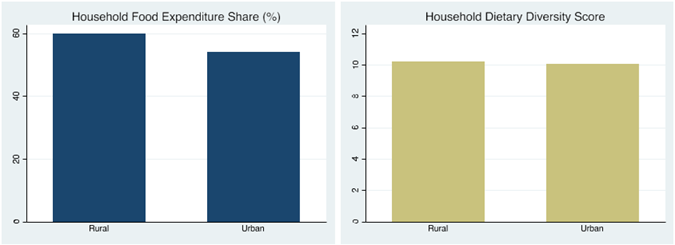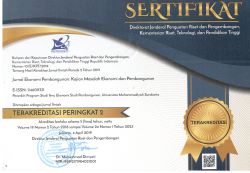Evidence on the Beneficial Impact of Food Voucher Programs in Java Island
DOI:
https://doi.org/10.23917/jep.v26i1.10693Keywords:
Food voucher, Welfare, Java, Multi-arm InterventionAbstract
This study aims to compare the effects of two food voucher programs on household welfare in Indonesia, namely the BPNT and Sembako Program, focusing on Java Island. It uses household food expenditure share (FES) and household dietary diversity score (HDDS) as outcome variables representing household welfare. This study utilizes the 2017–2021 cross-sectional data from the National Social Economic Survey (SUSENAS) published by the Central Bureau of Statistics. The Propensity Score Matching (PSM) and Ordinary Least Squares (OLS) methods were employed. The main estimate employs a multi-arm treatment approach to compare both programs to a common control group. By conducting PSM, this study controls about 76 observed characteristics of households. In addition, this method introduces time-variant and time-invariant fixed effects in the OLS estimation. The results show that the BPNT and Sembako Program decrease household FES and increase HDDS. The food voucher programs have different effects across provinces in Java, with food voucher programs tending to have greater effects in provinces with lower initial levels of welfare. Notably, the higher flexibility of the food voucher in the Sembako Program yields a greater effect on households. The higher flexibility of the food voucher allows beneficiaries to choose their food items other than rice and eggs. Thus, in addition to being effective in reducing FES, the Sembako Program is more effective in increasing HDDS. The policy implications directed at the government can improve targeting accuracy, voucher value, and infrastructure for accessing food vouchers, in alignment with the objectives set for the program.
Downloads
References
Abdulai, A., & Kuhlgatz, C. (2011). Food Security Policy in Developing Countries. In J. L. Lusk, J. Roosen, & J. F. Shogren (Eds.), The Oxford Handbook of the Economics of Food Consumption and Policy (pp. 343–369). Oxford University Press. https://doi.org/10.1093/oxfordhb/9780199569441.013.0014
Alatas, V., Banerjee, A., Hanna, R., Olken, B. A., & Tobias, J. (2012). Targeting the poor: Evidence from a field experiment in Indonesia. In American Economic Review (Vol. 102, Issue 4, pp. 1206–1240). https://doi.org/10.1257/aer.102.4.1206
Alfa, B. N., & Subagyo. (2018). Analysis of rice supply chain mechanism with simulation approach. IPTEK Journal of Proceedings Series.
Ali, M. K., Berglund, L., Flacking, R., Sulaiman, M., & Osman, F. (2024). Dietary diversity and associated factors among households and children in internally displaced person camps in Southern Somalia: A cross‐sectional study. Maternal & Child Nutrition, 20(4). https://doi.org/10.1111/mcn.13707
Ardianti, D. M., & Hartono, D. (2022). Internet Use and Agricultural Household Food Insecurity in Indonesia. Jurnal Ekonomi Pembangunan: Kajian Masalah Ekonomi Dan Pembangunan, 23(2), 179–191. https://doi.org/10.23917/jep.v23i2.18077
Athoillah, M., Bagus Wiguna, A., & Kornitasari, Y. (2022). The Effect of Ethnicity, Demographic and Socio-economic on Households’ Welfare in Indonesia. Advances in Economics, Business and Management Research, Volume 206.
Austin, P. C. (2011). An Introduction to Propensity Score Methods for Reducing the Effects of Confounding in Observational Studies. Multivariate Behavioral Research, 46(3), 399–424. https://doi.org/10.1080/00273171.2011.568786
Banerjee, A., Hanna, R., Olken, B. A., Satriawan, E., & Sumarto, S. (2023). Electronic Food Vouchers: Evidence from an At-Scale Experiment in Indonesia. American Economic Review, 113(2), 514–547. https://doi.org/10.1257/aer.20210461
Berg, G. D. (2011). An application of kernel-based versus one-to-one propensity score matching for a nonexperimental causal study: example from a disease management program evaluation. Applied Economics Letters, 18(5), 439–447. https://doi.org/10.1080/13504851003689692
Bizikova, L., Jungcurt, S., McDougal, K., & Tyler, S. (2020). How can agricultural interventions enhance contribution to food security and SDG 2.1? Global Food Security, 26, 100450. https://doi.org/10.1016/j.gfs.2020.100450
BPS. (2017). Pengeluaran Untuk Konsumsi Penduduk Indonesia, Maret 2017.
BPS. (2019). Profil Kemiskinan di Indonesia Maret 2019.
Brueckner, M., & Lederman, D. (2018). the role of initial income. Journal of Economic Growth, 23(3), 341–366. https://www.jstor.org/stable/48700616
Caliendo, M., & Kopeinig, S. (2008). Some Practical Guidance for the Implementation of Propensity Score Matching. Journal of Economic Surveys, 22(1), 31–72. https://doi.org/10.1111/j.1467-6419.2007.00527.x
Dewi, M. M., & Pangaribowo, E. H. (2022). The Effectiveness of Targeting Food Assistance Program in Indonesia. In • Southeast Asian Journal of Economics (Vol. 10, Issue 1).
Doocy, S., Busingye, M., Lyles, E., Colantouni, E., Aidam, B., Ebulu, G., & Savage, K. (2020). Cash and voucher assistance and children’s nutrition status in Somalia. Maternal and Child Nutrition, 16(3). https://doi.org/10.1111/mcn.12966
Elmes, M. B. (2018). Economic Inequality, Food Insecurity, and the Erosion of Equality of Capabilities in the United States. Business & Society, 57(6), 1045–1074. https://doi.org/10.1177/0007650316676238
Garrido, M. M., Kelley, A. S., Paris, J., Roza, K., Meier, D. E., Morrison, R. S., & Aldridge, M. D. (2014). Methods for Constructing and Assessing Propensity Scores. Health Services Research, 49(5), 1701–1720. https://doi.org/10.1111/1475-6773.12182
Hanna, R., & Olken, B. A. (2018). Universal basic incomes versus targeted transfers: Anti-poverty programs in developing countries. Journal of Economic Perspectives, 32(4), 201–226. https://doi.org/10.1257/jep.32.4.201
Hermawan, I., Izzaty, Budiyanti, E., Sari, R., Sudarwati, Y., & Teja, M. (2021). The Effectiveness of Non-Cash Food Assistance Program in Yogyakarta City. Jurnal Ekonomi & Kebijakan Publik, 12(2), 131–145. https://doi.org/10.22212/jekp.v12i1.2237
Hidayat, F., Hanri, M., Sastiono, P., & Moeis, J. P. (2022). Regional Analysis of In-Kind and E-Voucher Food Assistance: The Impact of Rastra and BPNT Programs to Meet Daily Calorie Needs in Indonesia. Universitas Indonesia.
Hidrobo, M., Hoddinott, J., Peterman, A., Margolies, A., & Moreira, V. (2014). Cash, food, or vouchers? Evidence from a randomized experiment in northern Ecuador. Journal of Development Economics, 107, 144–156. https://doi.org/10.1016/j.jdeveco.2013.11.009
Hirvonen, K. (2016). Rural–urban differences in children’s dietary diversity in Ethiopia: A Poisson decomposition analysis. Economics Letters, 147, 12–15. https://doi.org/10.1016/j.econlet.2016.08.003
Hoynes, H. W., & Schanzenbach, D. W. (2009). Consumption Responses to In-Kind Transfers: Evidence from the Introduction of the Food Stamp Program. American Economic Journal: Applied Economics, 1(4), 109–139. https://doi.org/10.1257/app
Khoiriyah, N., Anindita, R., Hanani, N., & Muhaimin, A. W. (2019). Animal Food Demand in Indonesian Rural: A Quadratic Almost Ideal Demand System Approach. Wacana Journal of Social and Humanity Studies, 22(2).
Kis-Katos, K., & Sparrow, R. (2015). Poverty, labor markets and trade liberalization in Indonesia. Journal of Development Economics, 117, 94–106. https://doi.org/10.1016/j.jdeveco.2015.07.005
Kolliesuah, N. P., Olum, S., & Ongeng, D. (2023). Status of household dietary diversity and associated factors among rural and urban households of Northern Uganda. BMC Nutrition, 9(1), 83. https://doi.org/10.1186/s40795-023-00739-4
Kronebusch, N., & Damon, A. (2019). The impact of conditional cash transfers on nutrition outcomes: Experimental evidence from Mexico. Economics and Human Biology, 33, 169–180. https://doi.org/10.1016/j.ehb.2019.01.008
McDowell, D. R., Allen‐Smith, J. E., & McLean‐Meyinsse, P. E. (1997). Food Expenditures and Socioeconomic Characteristics: Focus on Income Class. American Journal of Agricultural Economics, 79(5), 1444–1451. https://doi.org/10.2307/1244359
Mehraban, N., & Ickowitz, A. (2021). Dietary diversity of rural Indonesian households declines over time with agricultural production diversity even as incomes rise. Global Food Security, 28, 100502. https://doi.org/10.1016/j.gfs.2021.100502
Michelson, H., Lentz, E. C., Mulwa, R., Morey, M., Cramer, L., McGlinchy, M., & Barrett, C. B. (2012). Cash, food, or vouchers? An application of the Market Information and Food Insecurity Response Analysis Framework in urban and rural Kenya. Food Security, 4(3), 455–469. https://doi.org/10.1007/s12571-012-0177-0
Oster, E. (2019). Unobservable Selection and Coefficient Stability: Theory and Evidence. Journal of Business & Economic Statistics, 37(2), 187–204. https://doi.org/10.1080/07350015.2016.1227711
Prasada, I. M. Y., & Masyhuri. (2019). Food security in Java Island, Indonesia: Panel data of ordinary least square approach. IOP Conference Series: Earth and Environmental Science, 346(1). https://doi.org/10.1088/1755-1315/346/1/012065
Rachman, B., Agustian, A., & Wahyudi, N. (2018). Efektivitas dan Perspektif Pelaksanaan Program Beras Sejahtera (Rastra) dan Bantuan Pangan Non-Tunai (BPNT). Analisis Kebijakan Pertanian, 16(1), 1. https://doi.org/10.21082/akp.v16n1.2018.1-18
Rachman, H. P. S., & Ariani, M. (2008). Penganekaragaman Konsumsi Pangan Di Indonesia: Permasalahan Dan Implikasi Untuk Kebijakan Dan Program. Analisis Kebijakan Pertanian, 6(2), 140–154. https://doi.org/10.21082/akp.v6n2.2008.140-154
Rahayu, R. S., Purwaningsih, Y., & Daerobi, A. (2019). Mapping Of Provincial Food Security In Indonesia Using Based Clustering Model. Jurnal Ekonomi Pembangunan: Kajian Masalah Ekonomi Dan Pembangunan, 20(1), 69–79. https://doi.org/10.23917/jep.v20i1.7096
Sadono, E. D. (2018). Impact Evaluation of Raskin Program using Matching Method: Case of IFLS 5. JEJAK, 11(1), 207–223. https://doi.org/10.15294/jejak.v11i1.9192
Savy, M., Fortin, S., Kameli, Y., Renault, S., Couderc, C., Gamli, A., Amouzou, K., Perenze, M. L., & Martin-Prevel, Y. (2020). Impact of a food voucher program in alleviating household food insecurity in two cities in Senegal during a food price crisis. Food Security, 12(2), 465–478. https://doi.org/10.1007/s12571-019-00996-xï
Setiawan, A. H., Agunggunanto, E. Y., & Hayati, B. (2020). Analysis of Poverty and Inequality in Java, Bali, and Lampung. Economics Development Analysis Journal, 9(1), 55–64. https://doi.org/10.15294/edaj.v9i1.37865
Sinaga, R., Hutagaol, M. P., Hartoyo, S., & Nuryartono, N. (2021). Food Diversification in Java. International Journal of Science and Society, 3(3), 382–389. https://doi.org/10.54783/ijsoc.v3i3.383
Sinaga, R., Hutagaol, M. P., Hartoyo, S., & Nuryartono, R. N. (2022). Analysis Food Demand of Java Households with Aids Model Estimates. Media Ekonomi Dan Manajemen, 37(1), 96–108. https://doi.org/10.24856/mem.v37i1.2550
Sugiharti, D. S. S. (2020). The Economic Factors Affecting Food Security in Central Java. The 4th International Conference on Regional Development2020.
Suryana, E. A., Martianto, D., & Farida Baliwati, Y. (2021). Consumption, Elasticity and Demand Estimation of Animal Sources Food in Indonesia. Agrisocionomics: Jurnal Sosial Ekonomi Pertanian, 5(2), 168–179. https://doi.org/10.14710/agrisocionomics.v5i2.9905
Weerasekara, P. C., Withanachchi, C. R., Ginigaddara, G. A. S., & Ploeger, A. (2020). Understanding Dietary Diversity, Dietary Practices and Changes in Food Patterns in Marginalised Societies in Sri Lanka. Foods, 9(11), 1659. https://doi.org/10.3390/foods9111659
Wirba, E. L. (2023). Identification and estimation of quadratic food Engel curves evidence from Cameroon (523).
Yuliana, S., Teguh, M., & Imelda, I. (2020). Socioeconomic Characteristic of Household Food Security in South Sumatra. Proceedings of the 5th Sriwijaya Economics, Accounting, and Business Conference (SEABC 2019), 142. https://doi.org/10.2991/aebmr.k.200520.032
Yuniarti, D., Purwaningsih, Y., Soesilo, A., & Suryantoro, A. (2022). Food Diversification and Dynamic Food Security: Evidence from Poor Households. Jurnal Ekonomi Pembangunan: Kajian Masalah Ekonomi Dan Pembangunan, 23(1), 43–55. https://doi.org/10.23917/jep.v23i1.16302
Zaki, A., & Sulistyaningrum, E. (2021). Evaluasi Dampak Program Sembako terhadap Konsumsi Kalori, Karbohidrat, Protein, dan Lemak serta Proporsi Pengeluaran Non Makanan pada Rumah Tangga Penerima Manfaat di Pulau Papua Tahun 2020. Universitas Gadjah Mada.

Submitted
Accepted
Published
How to Cite
Issue
Section
License
Copyright (c) 2025 Nur Afini Muliandari, Rus'an Nasrudin

This work is licensed under a Creative Commons Attribution 4.0 International License.













